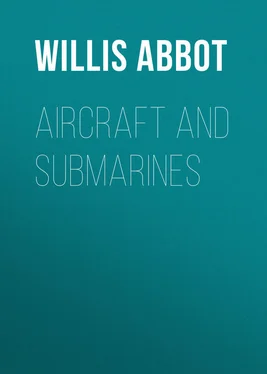Willis Abbot - Aircraft and Submarines
Здесь есть возможность читать онлайн «Willis Abbot - Aircraft and Submarines» — ознакомительный отрывок электронной книги совершенно бесплатно, а после прочтения отрывка купить полную версию. В некоторых случаях можно слушать аудио, скачать через торрент в формате fb2 и присутствует краткое содержание. Жанр: foreign_antique, foreign_prose, на английском языке. Описание произведения, (предисловие) а так же отзывы посетителей доступны на портале библиотеки ЛибКат.
- Название:Aircraft and Submarines
- Автор:
- Жанр:
- Год:неизвестен
- ISBN:нет данных
- Рейтинг книги:4 / 5. Голосов: 1
-
Избранное:Добавить в избранное
- Отзывы:
-
Ваша оценка:
- 80
- 1
- 2
- 3
- 4
- 5
Aircraft and Submarines: краткое содержание, описание и аннотация
Предлагаем к чтению аннотацию, описание, краткое содержание или предисловие (зависит от того, что написал сам автор книги «Aircraft and Submarines»). Если вы не нашли необходимую информацию о книге — напишите в комментариях, мы постараемся отыскать её.
Aircraft and Submarines — читать онлайн ознакомительный отрывок
Ниже представлен текст книги, разбитый по страницам. Система сохранения места последней прочитанной страницы, позволяет с удобством читать онлайн бесплатно книгу «Aircraft and Submarines», без необходимости каждый раз заново искать на чём Вы остановились. Поставьте закладку, и сможете в любой момент перейти на страницу, на которой закончили чтение.
Интервал:
Закладка:
Came now the next great step in the progress of aeronautics. It had been demonstrated that balloons could lift themselves. They had even been made to lift dumb animals and restore them to earth unhurt. But if the conquest of the air was to amount to anything, men must go aloft in these new machines. Lives must be risked to demonstrate a theory, or to justify a calculation. Aeronautics is no science for laboratory or library prosecution. Its battles must be fought in the sky, and its devotees must be willing to offer their lives to the cause. In that respect the science of aviation has been different from almost any subject of inquiry that has ever engaged the restless intellect of man, unless perhaps submarine navigation, or the invention of explosives. It cannot be prosecuted except with a perfect willingness to risk life. No doubt this is one of the reasons why practical results seemed so long in the coming. Nor have men been niggardly in this enforced sacrifice. Though no records of assured accuracy are available, the names of forty-eight aeronauts who gave up their lives in the century following the Montgolfiers' invention are recorded. That record ended in 1890. How many have since perished, particularly on the battlefields of Europe where aircraft are as commonplace as cannon, it is too early yet to estimate.
After the success of the ascension from the Champ de Mars , the demand at once arose for an ascension by a human being. It was a case of calling for volunteers. The experiments already made showed clearly enough that the balloon would rise high in air. Who would risk his life soaring one thousand feet or more above the earth, in a flimsy bag, filled with hot air, or inflammable gas, without means of directing its course or bringing it with certainty and safety back to a landing place? It was a hard question, and it is interesting to note that it was answered not by a soldier or sailor, not by an adventurer, or devil-may-care spirit, but by a grave and learned professor of physical science, Pilatre de Rozier. Presently he was joined in his enterprise by a young man of the fashionable world and sporting tastes, the Marquis d'Arlandes. Aristocratic Paris took up aviation in the last days of the eighteenth century, precisely as the American leisure class is taking it up in the first days of the twentieth.
The balloon for this adventure was bigger than its predecessors and for the first time a departure was taken from the spherical variety – the gas bag being seventy-four feet high, and forty-eight feet in diameter. Like the first Montgolfier balloons it was to be inflated with hot air, and the car was well packed with bundles of fuel with which the two aeronauts were to fill the iron brazier when its fires went down. The instinct for art and decoration, so strong in the French mind, had been given full play by the constructors of this balloon and it was painted with something of the gorgeousness of a circus poster.
A tremendous crowd packed the park near Paris whence the ascent was made. Always the spectacle of human lives in danger has a morbid attraction for curiosity seekers, and we have seen in our own days throngs attracted to aviation congresses quite as much in the expectation of witnessing some fatal disaster, as to observe the progress made in man's latest conquest over nature. But in this instance the occasion justified the widest interest. It was an historic moment – more epoch-making than those who gathered in that field in the environs of Paris could have possibly imagined. For in the clumsy, gaudy bag, rolling and tossing above a smoky fire lay the fundamentals of those great airships that, perfected by the persistence of Count Zeppelin, have crossed angry seas, breasted fierce winds, defied alike the blackest nights and the thickest fogs to rain their messages of death on the capital of a foe.
Contemporary accounts of this first ascension are but few, and those that have survived have come down to us in but fragmentary form. It was thought needful for two to make the ascent, for the car, or basket, which held the fire hung below the open mouth of the bag, and the weight of a man on one side would disturb the perfect equilibrium which it was believed would be essential to a successful flight. The Marquis d'Arlandes in a published account of the brief flight, which sounds rather as if the two explorers of an unknown element were not free from nervousness, writes:
"Our departure was at fifty-four minutes past one, and occasioned little stir among the spectators. Thinking they might be frightened and stand in need of encouragement I waved my arm."
This solicitude for the fears of the spectators, standing safely on solid earth while the first aeronauts sailed skywards, is characteristically Gallic. The Marquis continues:
M. de Rozier cried: "You are doing nothing, and we are not rising." I stirred the fire and then began to scan the river, but Pilatre again cried: "See the river. We are dropping into it!" We again urged the fire, but still clung to the river bed. Presently I heard a noise in the upper part of the balloon, which gave a shock as though it had burst. I called to my companion: "Are you dancing?" The balloon by this time had many holes burnt in it and using my sponge I cried that we must descend. My companion however explained that we were over Paris and must now cross it; therefore raising the fire once more we turned south till we passed the Luxembourg, when, extinguishing the flames, the balloon came down spent and empty.
If poor Pilatre played the part of a rather nervous man in this narrative he had the nerve still to go on with his aeronautical experiments to the point of death. In 1785 he essayed the crossing of the English Channel in a balloon of his own design, in which he sought to combine the principles of the gas and hot-air balloons. It appears to have been something like an effort to combine nitro-glycerine with an electric spark. At any rate the dense crowds that thronged the coast near Boulogne to see the start of the "Charles – Montgolfier" – as the balloon was named after the originators of the rival systems – saw it, after half an hour's drift out to sea, suddenly explode in a burst of flame. De Rozier and a friend who accompanied him were killed. A monument still recalls their fate, which however is more picturesquely recorded in the signs of sundry inns and cafés of the neighbourhood which offer refreshment in the name of Les Aviateurs Perdus .
Thereafter experimenters with balloons multiplied amazingly. The world thought the solution of the problem of flight had been found in the gas bag. Within two months a balloon capable of lifting eighteen tons and carrying seven passengers ascended three thousand feet at Lyons, and, though sustaining a huge rent in the envelope, because of the expansion of the gas at that height, returned to earth in safety. The fever ran from France to England and in 1784, only a year after the first Montgolfier experiments, Lunardi, an Italian aeronaut made an ascension from London which was viewed by King George III. and his ministers, among them William Pitt. But the early enthusiasm for ballooning quickly died down to mere curiosity. It became apparent to all that merely to rise into the air, there to be the helpless plaything of the wind, was but a useless and futile accomplishment. Pleasure seekers and mountebanks used balloons for their own purposes, but serious experimenters at once saw that if the invention of the balloon was to be of the slightest practical value some method must be devised for controlling and directing its flight. To this end some of the brightest intellects of the world directed their efforts, but it is hardly overstating the case to say that more than a century passed without any considerable progress toward the development of a dirigible balloon.
But even at the earlier time it was evident enough that the Quaker philosopher, from the American Colonies, not yet the United States, whose shrewd and inquiring disposition made him intellectually one of the foremost figures of his day, foresaw clearly the great possibilities of this new invention. In letters to Sir Joseph Banks, then President of the Royal Society of London, Franklin gave a lively account of the first three ascensions, together with some comments, at once suggestive and humorous, which are worth quoting:
Читать дальшеИнтервал:
Закладка:
Похожие книги на «Aircraft and Submarines»
Представляем Вашему вниманию похожие книги на «Aircraft and Submarines» списком для выбора. Мы отобрали схожую по названию и смыслу литературу в надежде предоставить читателям больше вариантов отыскать новые, интересные, ещё непрочитанные произведения.
Обсуждение, отзывы о книге «Aircraft and Submarines» и просто собственные мнения читателей. Оставьте ваши комментарии, напишите, что Вы думаете о произведении, его смысле или главных героях. Укажите что конкретно понравилось, а что нет, и почему Вы так считаете.












